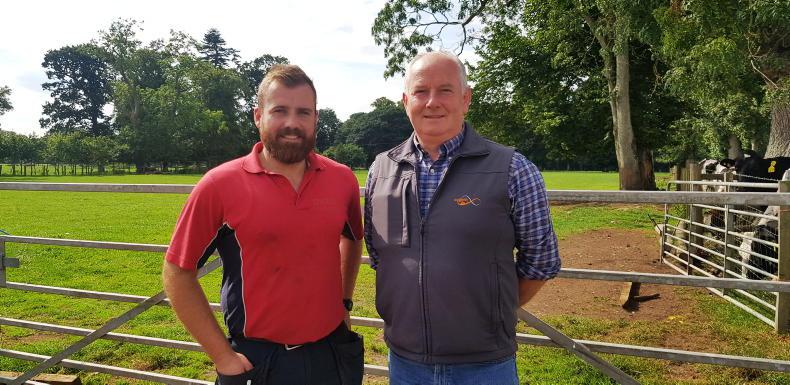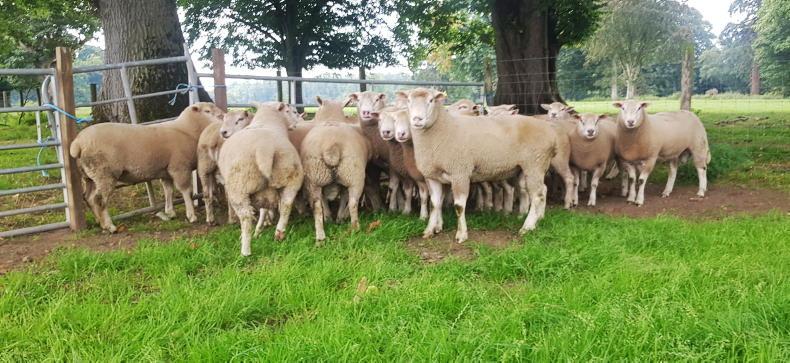Meatlinc is a sheep breed that has been specifically developed to produce a fast-growing and in-spec carcase from forage.
It was originally established by the late Henry Fell on his farm in Yorkshire in the 1960s. Similar to the Stabiliser cattle breed, it was developed as a composite by crossing five different sheep breeds.
Suffolk and Dorset rams were sourced in the UK and Charollais, Ille De France and Berrichon genetics were imported from France.
For the past 50 years or so, Meatlinc has been a breed in its own right and the genetics have been improved by selecting the top performers within the breed.
There are only a handful of designated Meatlinc breeders in the UK and Ireland and they sell rams direct from their own farms. The only Meatlinc breeder on the island of Ireland is Francis Connon, who farms in Limavady, Co Derry.
“We started breeding Meatlincs in 2012. We have 120 pedigree ewes and all rams are sold in the yard as shearlings,” Francis told the Irish Farmers Journal.
A key attribute of Meatlinc rams is that they are not pushed by feeding high levels of concentrates. It means they are reared in a system that is likely to be similar to the one operated by the commercial buyer.

Father and son Francis and Joe Connon farm near Limavady, Co Derry.
With most other sheep breeds, rams are mainly sold as ram lambs, so it is common to lamb ewes during winter months and introduce supplementary feed early on to get rams as big as possible by the autumn.
Later lambing
Francis can lamb his ewes relatively late on in April because he isn’t selling rams for another 14 or 15 months. It means he has a low-input system for his pedigree ewes, as well as having minimal inputs for growing his breeding rams that are destined for sale.
“We genuinely don’t feed them any meal, so the rams won’t melt when they go to another farm and are put out to ewes. With some other breeds, rams could be getting 4kg of meal every day so they will lose flesh as soon as they are sold,” Francis said.
“We want our rams to have a good working ability. They should be durable and have longevity. I sold a ram to a man once and he told me there were 1,000 tag numbers sired to that one ram over his lifetime.”

Meatlinc rams are not fed high levels of concentrates.
Francis doesn’t sell pedigree female stock, so he has a large number of potential replacements coming forward every year. This means he can implement a strict culling policy, so rams are only bred from ewes that require minimal attention.
The breed has been developed for lambs to have narrow heads and shoulders with plenty of vigour at birth. This is particularly suitable for outdoor lambing systems, which is something that Francis does most years as he doesn’t lamb until April.
“The Meatlincs don’t give much bother at lambing. We sometimes sell commercial crossbred ewe lambs that are in-lamb to Meatlinc rams. There have been times when these customers come back the next year to buy Meatlinc rams because they were easy lambed,” he said.
Carcase
As the name suggests, the Meatlinc breed is a terminal sire, and the main focus is to get a fast-growing, top-grading lamb carcase from a forage-based diet.
“Meatlinc lambs have great depth in the loin muscle. That’s what factories want because it’s where the most valuable cuts come from. Our customers have told us they see a lot more U-grades on their kill sheets when they start using Meatlincs,” Francis suggested.

All pedigree Meatlinc stock are performance recorded.
Those claims are backed up to an extent by a long-running independent study conducted on commercial farms across the UK. Ram Compare is a progeny testing programme which evaluates the performance of rams from various terminal sire breeds. Over 30,000 lambs have been performance recorded as part of the project and results from the sixth year of testing were published in May 2022. For an overall carcase merit index, which considers carcase weight, conformation, and fat class, Meatlinc rams took up three of the top five places.
The top-placed ram was a Charollais, bred by Worcestershire-based breeders MM and ML Rushbrooke. The second- and third-ranked terminal rams were Meatlincs bred by Clive and Jenny Richardson from Cornwall. Number four on the rankings was a Meatlinc ram by HR Fell and Sons Ltd, the breed’s founders.
Genetics based on performance data
A key difference between Meatlincs and other sheep breeds is that all pedigree stock have been performance recorded and the data from this is the foundation of genetic improvement.
Although performance recording is available for all sheep breeds in the UK and Ireland, uptake among breeders has been low in most instances.
All Meatlinc rams that are for sale on Francis Connon’s farm have Estimated Breeding Values for a long list of traits. This includes birth weight, muscle depth, fat depth, lambing ease, as well as liveweight at various ages.
There is an overall terminal sire index to make it easier to compare different rams within the breed. A maternal index has been developed more recently which reflects that Meatlinc-sired ewe lambs are also being kept for breeding stock on some farms.
“They are performance recorded as part of the Signet programme. Weights are recorded at birth, eight weeks, and 12 weeks and then Signet come out and do the CT scanning,” Francis explained.
“Some buyers are only interested in figures and will pick their rams based on the performance recording. Some people have no interest and just want stretchy looking rams, but most buyers go by both the figures and the look of the sheep,” he added.
Meatlinc is a sheep breed that has been specifically developed to produce a fast-growing and in-spec carcase from forage.
It was originally established by the late Henry Fell on his farm in Yorkshire in the 1960s. Similar to the Stabiliser cattle breed, it was developed as a composite by crossing five different sheep breeds.
Suffolk and Dorset rams were sourced in the UK and Charollais, Ille De France and Berrichon genetics were imported from France.
For the past 50 years or so, Meatlinc has been a breed in its own right and the genetics have been improved by selecting the top performers within the breed.
There are only a handful of designated Meatlinc breeders in the UK and Ireland and they sell rams direct from their own farms. The only Meatlinc breeder on the island of Ireland is Francis Connon, who farms in Limavady, Co Derry.
“We started breeding Meatlincs in 2012. We have 120 pedigree ewes and all rams are sold in the yard as shearlings,” Francis told the Irish Farmers Journal.
A key attribute of Meatlinc rams is that they are not pushed by feeding high levels of concentrates. It means they are reared in a system that is likely to be similar to the one operated by the commercial buyer.

Father and son Francis and Joe Connon farm near Limavady, Co Derry.
With most other sheep breeds, rams are mainly sold as ram lambs, so it is common to lamb ewes during winter months and introduce supplementary feed early on to get rams as big as possible by the autumn.
Later lambing
Francis can lamb his ewes relatively late on in April because he isn’t selling rams for another 14 or 15 months. It means he has a low-input system for his pedigree ewes, as well as having minimal inputs for growing his breeding rams that are destined for sale.
“We genuinely don’t feed them any meal, so the rams won’t melt when they go to another farm and are put out to ewes. With some other breeds, rams could be getting 4kg of meal every day so they will lose flesh as soon as they are sold,” Francis said.
“We want our rams to have a good working ability. They should be durable and have longevity. I sold a ram to a man once and he told me there were 1,000 tag numbers sired to that one ram over his lifetime.”

Meatlinc rams are not fed high levels of concentrates.
Francis doesn’t sell pedigree female stock, so he has a large number of potential replacements coming forward every year. This means he can implement a strict culling policy, so rams are only bred from ewes that require minimal attention.
The breed has been developed for lambs to have narrow heads and shoulders with plenty of vigour at birth. This is particularly suitable for outdoor lambing systems, which is something that Francis does most years as he doesn’t lamb until April.
“The Meatlincs don’t give much bother at lambing. We sometimes sell commercial crossbred ewe lambs that are in-lamb to Meatlinc rams. There have been times when these customers come back the next year to buy Meatlinc rams because they were easy lambed,” he said.
Carcase
As the name suggests, the Meatlinc breed is a terminal sire, and the main focus is to get a fast-growing, top-grading lamb carcase from a forage-based diet.
“Meatlinc lambs have great depth in the loin muscle. That’s what factories want because it’s where the most valuable cuts come from. Our customers have told us they see a lot more U-grades on their kill sheets when they start using Meatlincs,” Francis suggested.

All pedigree Meatlinc stock are performance recorded.
Those claims are backed up to an extent by a long-running independent study conducted on commercial farms across the UK. Ram Compare is a progeny testing programme which evaluates the performance of rams from various terminal sire breeds. Over 30,000 lambs have been performance recorded as part of the project and results from the sixth year of testing were published in May 2022. For an overall carcase merit index, which considers carcase weight, conformation, and fat class, Meatlinc rams took up three of the top five places.
The top-placed ram was a Charollais, bred by Worcestershire-based breeders MM and ML Rushbrooke. The second- and third-ranked terminal rams were Meatlincs bred by Clive and Jenny Richardson from Cornwall. Number four on the rankings was a Meatlinc ram by HR Fell and Sons Ltd, the breed’s founders.
Genetics based on performance data
A key difference between Meatlincs and other sheep breeds is that all pedigree stock have been performance recorded and the data from this is the foundation of genetic improvement.
Although performance recording is available for all sheep breeds in the UK and Ireland, uptake among breeders has been low in most instances.
All Meatlinc rams that are for sale on Francis Connon’s farm have Estimated Breeding Values for a long list of traits. This includes birth weight, muscle depth, fat depth, lambing ease, as well as liveweight at various ages.
There is an overall terminal sire index to make it easier to compare different rams within the breed. A maternal index has been developed more recently which reflects that Meatlinc-sired ewe lambs are also being kept for breeding stock on some farms.
“They are performance recorded as part of the Signet programme. Weights are recorded at birth, eight weeks, and 12 weeks and then Signet come out and do the CT scanning,” Francis explained.
“Some buyers are only interested in figures and will pick their rams based on the performance recording. Some people have no interest and just want stretchy looking rams, but most buyers go by both the figures and the look of the sheep,” he added.









 This is a subscriber-only article
This is a subscriber-only article










SHARING OPTIONS: